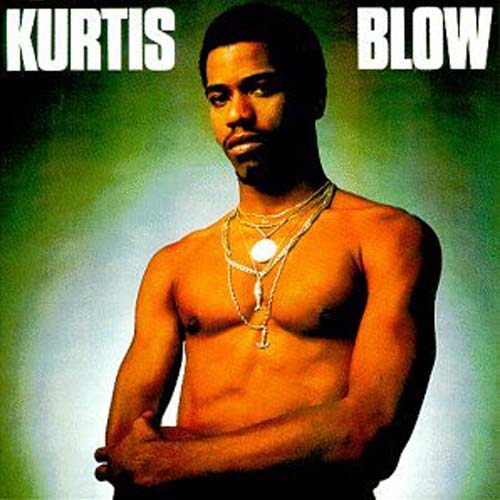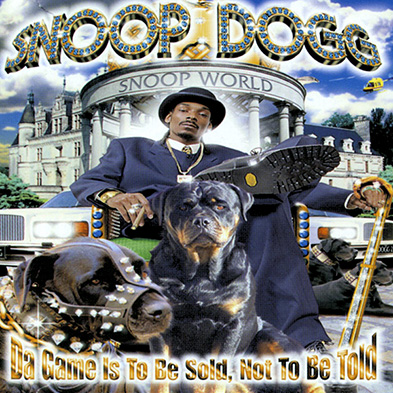

A visual comparison and analysis of the Kurtis Blow's self titled 1980 debut album cover, and the cover of Snoop Dogg's 1998 album, Da Game Is to Be Sold, Not to Be Told, will further reinforce my assertions pertaining to the commodification of hip-hop music. At first glance, one can immediately recognize the differences between the two images. Blow's album cover is extremely simple, while Snoop's is extremely complex. Furthermore, there is significantly less text present on the cover of Kurtis Blow's album.
On Blow's album cover he is wearing a limited amount of jewelry. Additionally, the image contains only the image of Blow (shirtless) paired with text indicating his name (which is also the title of the album). This simplicity indicates that Blow desires his listeners to focus on the music, rather than any ostentatious displays of social status. I assert that this ultimately indicates that early hip-hop existed primarily as a means through which one could express their thoughts ideas and emotions, rather than as an attempt to stimulate the listener consumption of material objects. An analysis of Snoop Dogg's album art will highlight the ways in which the discursive aims of hip-hop (and the images associated with it) have drastically shifted in recent decades.


Snoop Dogg's album cover depicts him sitting in front what appears to be some sort of residential palace or mansion. The viewer is positioned as Snoop's feet, thus they are forced to look up at him and his displays of wealth. Snoop's dogs (one wearing a diamond encrusted muzzle), lavish residence, gold cane, car, jewels, and clothing signify his wealth and power in the hip-hop world. This is anchored by the text, "Snoop World". The denotated meaning of this image is simply that Snoop Dogg is a wealthy individual, who possess a large number of material objects. Yet, these objects work together in an attempt to connote that idea that Snoop has gained his power and wealth (and realization of the American Dream) through hip-hop music. The text, "Da Game Is to Be Sold, Not to Be Told", serves to anchor this connotated meaning. Furthermore, it ultimately proves the idea that the value of hip-hop no longer rests in its ability to serve as a medium through which individuals can express their views on various societal issues (in the hopes that listeners will reflect on these issues and inspire social change). Instead, it currently promotes the consumption of material goods and encourages specific attitudes, which ultimately increase the wealth of existing hip-hop producers and artists.
In closing, the discursive formation, or "the way meanings are connected together in a particular discourse", of specific images (album covers) within the hip-hop industry displays a shift in the cultural and societal significance of the genre (Rose 191). Hip-hop has deviated from its previous role, no longer operating as a means to promote the societal awareness of various issues (social, cultural, political, etc.) in an effort to incite social reflection and change. Instead, the genre now blends, "ethereal instrumentation with wistful lyrics that offer alternating visions of ghetto upward mobility, intoxication devoid of either physical side effect or legal penalty, [and] unlimited access to sexual pleasure" (Smith 81). Through the combination of cultural and discursive methods of analysis it is clear that modern hip-hop frequently interpellates listeners and fans as consumers in order to increase the wealth and status of the artists within the genre. Gonzalez and Hayes indicate that as hip-hop has become, "increasingly popular, individuals have begun to infuse their interpretation of rap lyrics into their person lifestyles" (Gonzalez 165). These individuals idolize the industry's stars, and view the ways in which rappers achieve a version of the American Dream. Fans attempt to attain this dream through materialistic endeavors and the act of conspicuous consumption. Rather than focusing provocative on the creation lyrics and images that signify the importance of societal change, modern hip-hop focuses on the superficial and material benefits that one gains from "making it". Consumers no longer care about the struggles associated with the genres origins (inequality, discrimination, poverty, etc.), they are simply concerned with the materialistic nature/depictions of those who reside at the top of the hip-hop industry.